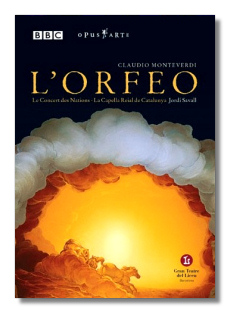
The Internet's Premier Classical Music Source
Related Links
- Monteverdi Reviews
- Latest Reviews
- More Reviews
-
By Composer
-
Collections
DVD & Blu-ray
Books
Concert Reviews
Articles/Interviews
Software
Audio
Search Amazon
Recommended Links
Site News
 DVD Review
DVD Review
Claudio Monteverdi

L'Orfeo
- Furio Zanasi (Orfeo)
- Montserrat Figueras (La Musica)
- Arianna Savall (Euridice)
- Sara Mingardo (Messagiero)
- Cécile van de Sant (Speranza)
La Capella Reial de Catalunya
Le Concert des Nations/Jordi Savall
BBC Opus Arte OA0843D DVD 140min LPCM Stereo Dolby Digital Anamorphic Widescreen
Taped live in Barcelona's Gran Teatre del Liceu on January 31, 2002, this L'Orfeo is both a visual delight and a musically satisfying representation of Monteverdi's opera. L'Orfeo was first performed (it is thought) in the so-called "Hall of Mirrors" in Mantua's Palazzo Ducale in 1607. Stage director Gilbert Deflo was inspired by that location when he created this production, to the extent of even lowering a mirrored curtain behind the proscenium arch at different points in the action. Deflo has put modern technology at the service of a concept that is very classical in style. Scenery glides up and down and left and right noiselessly. At the end of the opera, Apollo's descent from the skies in his sun chariot is a real moment of spectacle, but Deflo makes no attempt to hide the cables, neatly melding the old with the new and the fantastic with the realistic. Glowing backdrops, even at their most gloomy, create realistic environments, from the fields of Thrace to the underworld itself. Mood is everything in this production.
Twenty years ago, it was not uncommon for Monteverdi's operas to be fed on a diet of bread of water. Acerbic performance practices and pinched, puny instrumentation made these works seem severe. Savall, a Spaniard, warms L'Orfeo with the Mediterranean sun. A large ensemble of authentic instruments plays passionately. Harpsichord and organ, so prominent in older attempts at presenting L'Orfeo, here give way to the warmth of brass and stringed instruments. It was Deflo's idea to dress Savall as the composer, and to have him stride through the audience to the podium during the opening toccata. Perhaps Monteverdi would have applauded this harmless conceit, given the heat and immediacy of Savall's interpretation.
The close camera work adores the singers, whose expressive faces are responsible for most of the acting. Deflo was inspired by Japanese Noh drama in his use of slow, stylized body movements. The standout is Sara Mingardo. As the unhappy Messenger who announces Euridice's death, she makes an indelible impression not only through her singing, but also through her face, her hands, and her posture. Furio Zanasi is a little too elderly and stout to be an ideal Orfeo, but his facial expressions convey the fullness of this character to perfection, and his singing, while classical in style, is full of pathos and expression. The many small but important roles are filled with confidence. Some of the women (Figueras, Arianna Savall) seem to be forcing their voices to fill the theater, however. This is to be expected, as it is difficult to translate the intimacy of Monteverdi to the grandeur of the Liceu. It is believed that L'Orfeo's first audience numbered two hundred, if that many, so of course some allowances need to be made if it is to be performed for an audience ten times that size.
The most important bonus on this DVD is an interview with Deflo in and around the Palazzo Ducale. It might be a good idea to watch this interview before watching the production, as it will assist viewers in understanding why Deflo made the choices he did.
Superior sound (stereo and digital surround) and visuals (16/9 anamorphic) make it easy to enjoy this DVD, if the opera itself and the production were not enough.
Copyright © 2003, Raymond Tuttle


















